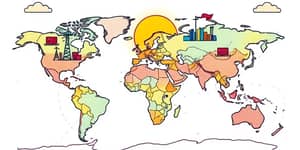As the world charts its course into 2025, nations and businesses brace for a complex interplay of challenges and opportunities. This outlook offers an analytical yet inspiring guide to navigating the year ahead with resilience, innovation, and optimism.
Global Growth Projections and Regional Breakdown
Recent forecasts place global GDP growth for 2025 between 2.7 and 3.3 percent, a pace that remains below the two-decade average. Institutions like the OECD, IMF, UN, and World Bank offer slightly varying projections, underscoring the need for adaptable strategies.
- OECD sees growth at 3.1 percent in 2025, easing to 3.0 percent in 2026
- IMF forecasts 3.3 percent in both 2025 and 2026
- UN projects 2.8 percent in 2025 and 2.9 percent in 2026
- World Bank expects a steady 2.7 percent through 2025 and 2026
Regionally, the United States is poised for about 2.2 percent expansion, slowing thereafter, while the Euro Area hovers around 1.0 to 1.2 percent. China’s growth decelerates toward 4.4 percent by 2026. Emerging markets display mixed trajectories, with Latin America and South Asia supported by robust domestic demand.
Inflation Trends and Monetary Policy Divergence
Global inflation is forecast to ease yet remain elevated above pre-pandemic norms. G20 economies face around 3.8 percent in 2025, tapering to 3.2 percent in 2026. Advanced and emerging markets diverge in their inflation journeys.
Central banks adopt cautious stances, reflecting persistent services and wage inflation. Desynchronized policies will characterize the monetary landscape: the Fed may pause before easing, eyeing sustained price pressures, while the ECB could cut rates more swiftly as eurozone inflation cools. The Bank of Japan balances potential tightening amid wage gains, China pursues easing to counter deflationary trends, and Latin American economies remain vigilant against resurgent price pressures.
Trade, Geopolitics, and Sectoral Dynamics
Global trade growth faces headwinds, with forecasts near 1.7 percent. Shifting supply chains, regional tensions, and the deepening of protectionist measures shape the outlook. Commodity markets add layers of complexity:
- Fuel prices may decline overall by nearly 8 percent
- Natural gas surges by over 22 percent due to geopolitical shifts
- Oil and coal prices trend downward by roughly 15 percent
- Nonfuel commodities see modest gains, while food prices edge higher
Businesses must adapt to the ebb and flow of regional demands and potential supply shocks arising from climate events or demographic shifts.
Financial Markets and Investment Themes
Stock markets bifurcate in performance, with U.S. equities leading. Analysts target the S and P 500 near 6500, driven by accelerated technological innovation and adoption in AI and automation. Japanese stocks stand to benefit from domestic reforms and a weak yen, while emerging markets present selective opportunities amid volatility.
Fixed income remains sensitive to policy signals. Investors gravitate toward duration in more stable regions and search for yield in higher-growth markets. Diversification and tactical positioning will be crucial to managing risk and seizing returns.
Structural Challenges and Policy Priorities
Despite pockets of strength, the global economy faces lingering impediments. High public and private debt burdens, demographic headwinds, and slow productivity growth limit long term potential. Many developing nations continue to recover from pandemic scars.
Policy makers are called to action. Priority areas include:
- Scale up infrastructure and digital connectivity
- Invest in human capital and education
- Advance sustainable green energy transition
- Implement debt relief and financial resilience measures
Opportunities and Long Term Outlook
The year ahead also frames an era of possibility. Technological breakthroughs, from AI to clean energy, promise to reshape industries and lifestyles. The global green transition could unlock new growth pathways, foster employment, and mitigate climate risks. However, benefits will not be evenly distributed, calling for cooperative frameworks and inclusive policies.
Resilience and adaptability are paramount. By leveraging data, strengthening institutions, and embracing innovation, stakeholders can steer toward a future that balances economic vitality with social and environmental stewardship.
As 2025 unfolds, decision makers can chart a course informed by rigorous analysis and guided by a shared vision of prosperity. Remarkable potential for resilience and progress endures for those ready to innovate and collaborate.
References
- https://www.oecd.org/en/about/news/press-releases/2025/03/global-economic-outlook-uncertain-as-growth-slows-inflationary-pressures-persist-and-trade-policies-cloud-outlook.html
- https://www.imf.org/en/Publications/WEO/Issues/2025/01/17/world-economic-outlook-update-january-2025
- https://www.imf.org/en/Blogs/Articles/2025/04/22/the-global-economy-enters-a-new-era
- https://www.ey.com/en_us/insights/strategy/global-economic-outlook
- https://www.un.org/development/desa/dpad/publication/world-economic-situation-and-prospects-february-2025-briefing-no-187/
- https://www.jpmorgan.com/insights/global-research/outlook/market-outlook
- https://www.imf.org/-/media/Files/Publications/WEO/2025/April/English/ch1.ashx
- https://www.worldbank.org/en/publication/global-economic-prospects










